Hippodraco
Hippodraco (meaning "horse dragon") is a genus of iguanodontian ornithopod dinosaur that lived in North America during the Early Cretaceous period. It contains a single species, H. scutodens, for which the holotype is an immature individual catalogued as UMNH VP 20208.[1]
| Hippodraco | |
|---|---|
 | |
| Preserved left side of the skull | |
| Scientific classification | |
| Kingdom: | Animalia |
| Phylum: | Chordata |
| Clade: | Dinosauria |
| Order: | †Ornithischia |
| Suborder: | †Ornithopoda |
| Clade: | †Styracosterna |
| Genus: | †Hippodraco McDonald et al., 2010 |
| Type species | |
| Hippodraco scutodens McDonald et al., 2010 | |
Discovery and naming

The holotype of Hippodraco, UMNH VP 20208, was discovered in 2004 by Andrew R. C. Milner. It is a fragmentary specimen including a fragmented skull and dentary teeth, vertebrae (dorsal, caudal and cervical), a right humerus, a right scapula, a left ischium, a right tibia, a right femur, and left metatarsals.[1]
It was later named in 2010 by Andrew T. McDonald, James I. Kirkland, Andrew R. C. Milner, Scott K. Madsen, Donald D. DeBlieux, Jennifer Cavin and Lukas Panzarin. The generic name Hippodraco is a combination of the Greek word hippos ("horse") and the Latin word draco ("dragon"). It refers to the elongated shape of the skull, which resembles a horse skull. The specific name scutodens is a combination of the Latin words scutum (meaning shield) and dens (meaning tooth), and it references the shield-shaped dentary tooth crowns. UMNH VP 20208 was unearthed from the Yellow Cat Member of the Cedar Mountain Formation, Utah, at a site known as Andrew's Site, dating from the Barremian stage in the Early Cretaceous period.[1]
Description


Hippodraco is a relatively small iguanodontid, with the holotype reaching 4.5 m (15 ft) in length. Holtz estimated its weight between 227 to 454 kg (500.4 to 1,000.9 lb).[2] However, a large orbital in the skull indicates that the specimen is immature. The left side of the skull is well preserved, although the right side is very fragmented. The left dentary is preserved on the skull along with teeth, which, have shield-shaped crowns. The lacrimal bone closely resembles those of Dakotadon and Theiophytalia. Vertebrae indicates a characteristic iguanodont body shape. Most of the body remains are gracile, such as the right humerus and scapula, the right tibia and femur are fragmented, having irregular surfaces. The nearly-complete metatarsus is very similar to those of Camptosaurus and Iguanodon.[1]
Paleoecology

The holotype of Hippodraco was unearthed from the Upper Yellow Cat Member of the Cedar Mountain Formation.[1] Contemporaneous fauna from the Upper Yellow Cat include the fellow ornithopod Cedrorestes, sauropods (Cedarosaurus and Moabosaurus), theropods (Martharaptor and Nedcolbertia), the nodosaurid Gastonia, and the giant dromaeosaurid Utahraptor.[3][4] Other dromaeosaurids with fragmentary remains are also known from the formation: an indeterminate eudromaeosaur (UMNH VP 20209) and an indeterminate velociraptorine (UMNH VP 21752).[5]
References
- McDonald AT, Kirkland JI, DeBlieux DD, Madsen SK, Cavin J, et al. (2010). "New Basal Iguanodonts from the Cedar Mountain Formation of Utah and the Evolution of Thumb-Spiked Dinosaurs". PLoS ONE. 5 (11): e14075. doi:10.1371/journal.pone.0014075. PMC 2989904. PMID 21124919.
- Holtz, T. R.; Rey, L. V. (2007). Dinosaurs: The Most Complete, Up-to-Date Encyclopedia for Dinosaur Lovers of All Ages. Random House. Supplementary Information 2012 Weight Information
- Paul, Gregory S. (2016). The Princeton Field Guide to Dinosaurs (2nd Edition). Princeton, New Jersey: Princeton University Press. pp. 151, 163, 229, 252, 314, 319, 326, 327. ISBN 9780691167664.
- Kirkland, J.I. (December 1, 2016). "The Lower Cretaceous in East-Central Utah—The Cedar Mountain Formation and its Bounding Strata". Geology of the Intermoutain West. 3: 1–130.
- Senter, P.; Kirkland, J. I.; Deblieux, D. D.; Madsen, S.; Toth, N. (2012). Dodson, Peter (ed.). "New Dromaeosaurids (Dinosauria: Theropoda) from the Lower Cretaceous of Utah, and the Evolution of the Dromaeosaurid Tail". PLoS ONE. 7 (5): e36790. doi:10.1371/journal.pone.0036790. PMC 3352940. PMID 22615813.

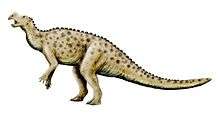

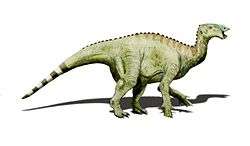
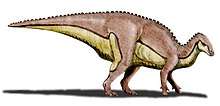
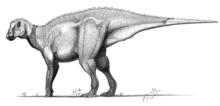
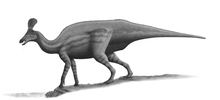
.jpg)